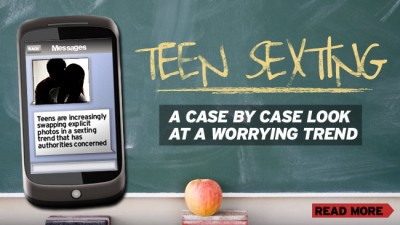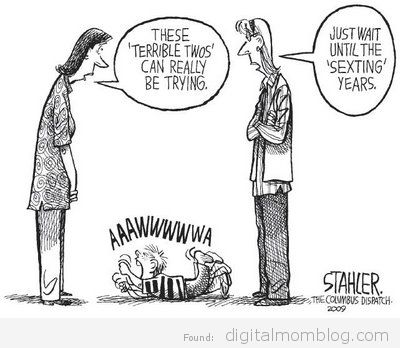One of these days I’ll find something to cite on the topic of Early Internet Adolescence that isn’t my own experience, but here goes: I like to joke that the Internet and I went through puberty at about the same time. As a result, I spent my teenage years on the cusp of being what we now think of as “connected”—I journaled on paper but wrote poetry on computers (also napkins); I wrote letter-length notes during class but sent email during my free periods; in general, I communicated with friends and family (as well as myself) through an array of both analog and digital media. Though sometimes I hung out talking to strangers in AOL chat rooms (especially before I had friends who, like me, didn’t have a curfew), my digitally mediated interactions were a lot like my telephone-mediated interactions in that they occurred primarily with people I already knew from in-person contexts.
Digitally mediated interaction was new and exciting (especially to a shy kid who already fancied herself a writer), but from the very beginning, it was just another piece of the life I was already living. It didn’t make me a new or different person (in contrast, sometimes I felt more free to be myself via email), and nor did my friends interact with me through chat or email in ways that were incongruous with the ways they interacted with me in person. So what were those interactions like, especially as my friends and I tried to navigate the complicated social- and emotional politics of attraction in the context of a small high school? This was back in the pre-SMS era, mind you, so to hear The Today Show’s Matt Lauer tell it last month, I should have been receiving graceful, articulate, hand-written notes from classmates who fancied me, and perhaps responding with notes of my own if the fledgling twitterpation was mutual.
Oddly enough, this is not what I remember happening.
In fact, I don’t even need to consult those old paper journals to remember that nearly everything about teenage courtship was f’ing awkward, both before and after we all got email at school and had a thrilling new way to flirt. (As I’ve argued elsewhere, I remain convinced that courtship and dating frequently just are awkward, period stop, degree of digital mediation notwithstanding.) Similarly, while it may have been the Web 1.0 era, my teenage courtship experiences were definitely mediated: Even if we forget that physically mediated (or “face-to-face”) interaction is mediated (guess what: it’s mediated!), getting into my first significant relationship was still a highly mediated process. The young man in question called to ask me out in lieu of saying something face-to-face (even though we worked closely together on our high school newspaper, and so saw each other anywhere from five to seven days a week), and that phone call itself was the culmination of a four-person game of telephone that took an entire Sunday afternoon (as two mutual friends spent hours calling each of us and then calling each other to compare notes, until the success of The Phone Call was certain enough for my soon-to-be boyfriend to pick up the phone). The technologically mediated interaction didn’t stop once we became a couple, either: out of the particular obsessive hunger for each other’s company that only teenagers can muster, we talked on the phone most nights and sent long emails back and forth and sometimes talked on AIM in addition to all of that, and we did so for almost a year. And it was still the 1990s.

Though some insist the plural of “anecdote” is not “data,” my adolescent experiences form just one more reason I remain convinced that—if there are indeed large-scale differences between Teen Courtship Now and Teen Courtship Then—these differences are not caused by the advent of any particular form of digital mediation (email, SMS, social networking sites, etc.), and nor are they caused by any particular social practice enacted through digital media (e.g., “sexting”). Instead, in what should be a familiar move by now, I argue that neither digital social technology nor “sexting” has caused “hookup culture” (which is itself a contentious and highly problematic framework), but rather that sexting makes a few larger, much more troubling phenomena more apparent. These phenomena include the following:
- The fact that some people choose to circulate photo-sexts that were intended to remain private. Forwarding a sext is a failure to understand respect, trust, and boundaries, while the shame and harassment that come to people whose sexts are forwarded are largely problems of sexism. Neither the decision to send a sext, nor the decision to forward a sext, is caused by digital media.
- The fact that we don’t teach kids (or adults) how to talk openly with each other about sex. Given this, how can we possibly be surprised if kids try to have sexual conversations by imitating movies, song lyrics, or other media they find on the Internet? For many kids (and adults), these are the only examples of sexual language and discourse that they are able to access.
- The fact that teenagers—of all genders—have sexual agency, and that many teenagers engage in sexual activity of some sort (which I don’t find troubling in and of itself, but a number of other adults sure do). It’s still a mystery how we can so fear teen sexuality, yet simultaneously so intently refuse to acknowledge that teenagers are sexual creatures—it’s almost as if we think that, by refusing to teach teenagers about respectful and responsible sex, we can somehow preserve a naïve pre-sexual innocence that, for most teens, is long gone by the time they’re fighting with iPhone autocorrect about the spelling of slang terms for genitalia.
In case you’re wondering why I’m feeling crotchety about sexting and technological determinism this week, a recent round of Blame It On The Sexts (Yeah, Yeah) got kicked off back in August by NBC—which both ran a segment on The Today Show and posted a corresponding website write-up inspired by Catherine Steiner-Adair’s book, The Big Disconnect: Protecting Childhood and Family Relationships in the Digital Age. (Habitual readers will recall that “disconnection” is just one of my favorite cultural criticism tropes.)

The TL;DR here is that boys and girls alike are supposedly “victims” of digital technology: Boys want meaningful romantic relationships with girls, but—because they have smartphones, and because they’ve learned about sex and sexuality from online porn—these boys go cluelessly about their attempts to kindle tender romance with SMS communiqués such as, “Well, I want my dick in your mouth?” The girls, on the other hand, are victims because they have to endure such messages, and because they don’t know how to tell boys that “hookup culture” hurts their feelings (NBC here treats “hookup culture” as something caused by “sexting,” even though Concerned Adults™ were going on about hookup culture well before anyone had ever heard the term “sexting”). Notably, if gay and lesbian teens were interviewed for Steiner-Adair’s book, NBC’s coverage makes no mention of that fact; all the teens discussed on The Today Show and in the article are engaged in heterosexual interactions, and presumed to be looking for ongoing sexual-emotional relationships.
Amanda Hess (@amandahess) lays out a great critique of NBC, in which she argues,
It’s great that Steiner-Adair is actually talking to boys, but it doesn’t sound like she fully understands the way that they text. Anyone who thinks that text messages lack nuance has failed to mine the vast emotional potential of the Emoji keyboard; those who believe that Internet porn is more extreme than ever aren’t remembering the bestiality and abuse that punctuated some stag films of the 1970s.
Hess goes on to make the point that—given young women’s greater risk of domestic- and partner violence—if some young women are trading in “real relationships” for “sexting,” this might not be such a bad thing. If sexting does lead to “arm’s length” relationships, then at least young women are less likely to become trapped in those relationships.
Jenny Davis (@Jenny_L_Davis) similarly praises Steiner-Adair for troubling the “boys as sext perpetrators, girls as sext victims” narrative, but argues that Steiner-Adair’s (and NBC’s) move to cast both boys and girls instead as victims of digital technology is both ill conceived and dangerous. As Davis writes,
To be sure, mediated sexual interaction is not always a growth facilitating thing. On the contrary, like all sexual interaction, it can be downright violent. In this vein, Steiner-Adair talks about girls crying as they recount explicit messages they’ve received, of boys hacking into each other’s accounts and sending girls crude messages about multi-hole penetration, of boys feeling pressured to re-enact the behaviors displayed in pornography. Such things are clearly troublesome. Such things represent a real social problem. Namely, Rape Culture.
The way the article addresses the issue, however, is to decry “hookup culture” with an emphasis on the role of particular technological objects. In doing so, new technologies become the surface level scapegoat, the convenient receptacle for social problems into which parents, commentators, educators, and policy makers can throw their blame, avoiding the mess of a largely imbedded social ill.
As Davis explains, viewing the harms that sometimes follow from sexting as a technology problem (instead of as signals toward much larger problems with sexism, rape culture, and the state of the U.S education system) leads parents and educators to formulate interventions that are not only unrealistic, but also counterproductive.
I’m going to spend the rest of this post trying to shed some light on why we’re so eager to blame digital technology for teen-related problems like “sexting” or, relatedly, “cyberbullying.” I argue that the fixation on digital mediation that characterizes both “sexting” and “cyberbullying” as concepts (as well as their attendant technological determinism) is rooted at least partially in digital dualism, and that digital dualism thereby serves to deflect attention away from some very real social problems. In short: Digital dualism doesn’t cause sexism (or other *-isms), but it does act in concert with sexism by deflecting critical attention away from sexism in action.
In a forthcoming paper, PJ Rey (@pjrey) and I revisit Amanda Todd’s 2012 suicide in order to examine the relationships between contemporary embodiment, augmented reality, and subjectivity. Following Todd’s death, journalists and researchers alike fixated on the “online” elements of Todd’s ordeal—as if the fact that both Todd and the people who tormented her had used digital communication technologies was the most important, interesting, or critical part of Todd’s story. PJ and I argue that the inflated salience of “onlineness,” in both the academic and popular versions of the subsequent frenzy about “cyberbullying,” stems directly from a false conceptual division between “online” and “offline” (in other words, digital dualism). Our related critique of the term “cyberbullying” can readily be extended to the hysteria around “sexting,” both of which repackage complex, multicausal social problems as simple, direct consequences of ‘bad’ technologies:
Todd’s suicide sparked a surge of interest in so-called “cyberbullying,” and yet the term grossly oversimplifies both what an unknown number of people did to Todd (across multiple media, and in multiple contexts) and why those people did such things in the first place. As danah boyd (@zephoria), Nathan Fisk, David A. Banks (@DA_Banks), and others argue, the term “cyberbullying” deflects attention away from harassment and abuse (“-bullying”), and redirects that attention toward digital media (“cyber-”). In so doing, the term “cyberbullying” allows digital media to be framed as causes of such bullying, rather than simply the newest type of mediation through which kids (and adults) are able to harass and abuse one another. “The Internet” and “social media” may be convenient scapegoats, but to focus so intensely on one set of media through which bullying sometimes takes place is to obscure the underlying causes of bullying, which are much larger and much more complicated than just the invention of new technologies like the Web. Such causes include (to name just a few): teens’ lack of positive adult involvement and mentorship; the contemporary conception of childhood as preparation for a competitive adult workforce, and the attendant emphasis on managing, planning, and scheduling children’s lives; a culture of hyper-individualism that rewards mean-spirited attacks, and that values “free speech” more highly than “respect”; sexism, misogyny, and “rape culture”. When we characterize digitally mediated harassment and abuse as “cyberbullying,” we sidestep confronting (or even acknowledging) any and all of these issues.
We would do well to ask: of all the factors that fed into Todd’s death, why did the ensuing public discourse center on “cyberbullying” as most salient? While Todd’s death is sociologically complicated, if we absolutely must boil everything down to a single cause, I argue that our collective finger should point at sexism, not the Internet. Sexism fuels the double standard for men’s and women’s sexuality upon which “[insulting] a woman because she expressed her sexuality in a way that does not conform with patriarchal expectations for women” (in other words, what some feminists have called “slut-shaming”) depends. Without sexism, and without its attendant double standards, an image of a young woman with exposed breasts loses its shame and its effectiveness as blackmail. Without sexism an image of breasts loses most of its power, and so too does the person who wields the image as a weapon. Fixating on digital technology, however, deflects attention not only from the individual humans who threaten, harass, and torment young (and not-so-young) people like Todd, but also from the social forces that enable and even position those individuals to do so. Fixating on digital technology prevents us not only from acknowledging social power vectors like sexism, but from asking who is harmed by—and who benefits from—the degree to which *-isms are entrenched in our social systems and structures.

In short, the fault for Todd’s death lies not in her webcam, but in the adult man who coerced a 13-year-old girl to show her breasts; then surreptitiously saved an image of her breasts; then used that image to blackmail her; then did his damnedest to make sure that everyone who knew her then, and everyone who came to know her subsequently, saw that image of her breasts. The fault for Todd’s death lies not in the Internet, but in everything about our society that enables a photograph of breasts to incite such ruthless, cruel, unceasing persecution. At no point should we think that by smashing a webcam or a router, we’ve somehow smashed patriarchy.
Similarly, if there’s something that bothers us about “sexting” and other courtship behaviors among teens (and it does seem that some people are very, very bothered), we would do well to examine what that really is—and why it really bothers us—rather than the fact that the range of sites where that ‘something’ is visible now includes glowing rectangles stashed in young pockets. If only the “stop staring at the phone” trope would collide with the sexting alarmists, we might finally be able to have a productive conversation about teen sexuality.
Whitney Erin Boesel (@weboesel) cheekily wonders why some readers will blame her—and not her computer or the Internet or whatever else—for the fact that she dropped The P-Word in the post above.
Lead image from here; blackboard image from here; fake sext from here; cat selfie from here.



Comments 3
Grace — September 4, 2013
I disagree that it's sexism at the core. It's about power and (dis)respect and privacy. It could have been any photo she wanted to keep private. She had a particular reason that this image carried more power or currency, but that's based in societal notions of sexuality and modesty, which can be influenced by sexism, but isn't itself sexist.
It's similar to saying rape isn't about sex, but about power. Of course, sex has something to do with it, or else another method of wielding power could have been used.
We live in a technological world and a sexist world. Technology can be used to bully or exploit people. Societal sexuality norms can be used to bully or exploit people. But whatever method is used, it's still about power.
Digital dualism, #DiversityinSFF, and imagining differently » Cyborgology — September 6, 2013
[...] a problematic approach to an understanding of lived reality and human experience but is also one that helps to prop up existing social inequalities, making positive change more [...]
Indecent Exposure: Breasts as Data, Data as Breasts » Cyborgology — June 19, 2014
[…] the worst one of all: “revenge porn” is a thing[iii], and a photograph of breasts can incite enough abuse to drive a young woman to […]